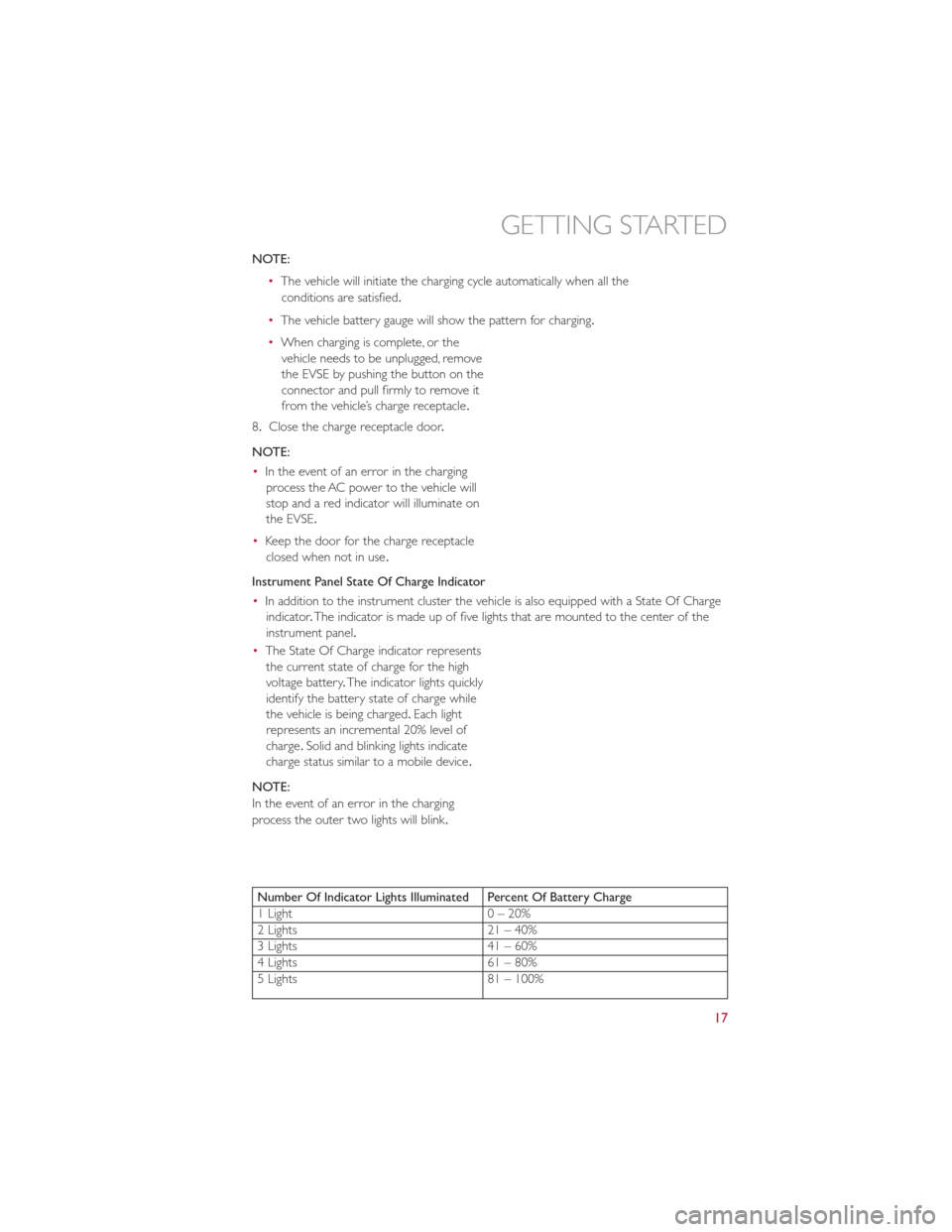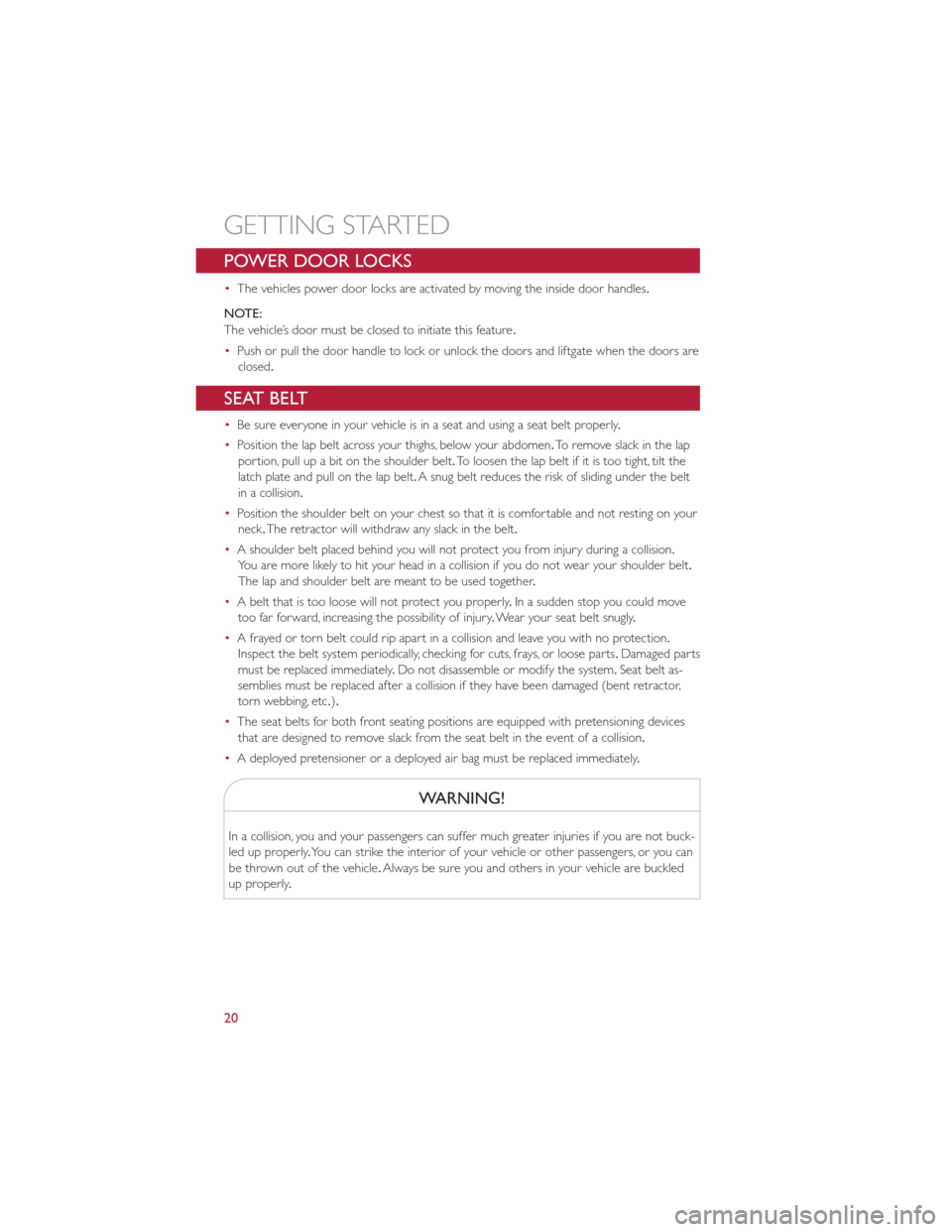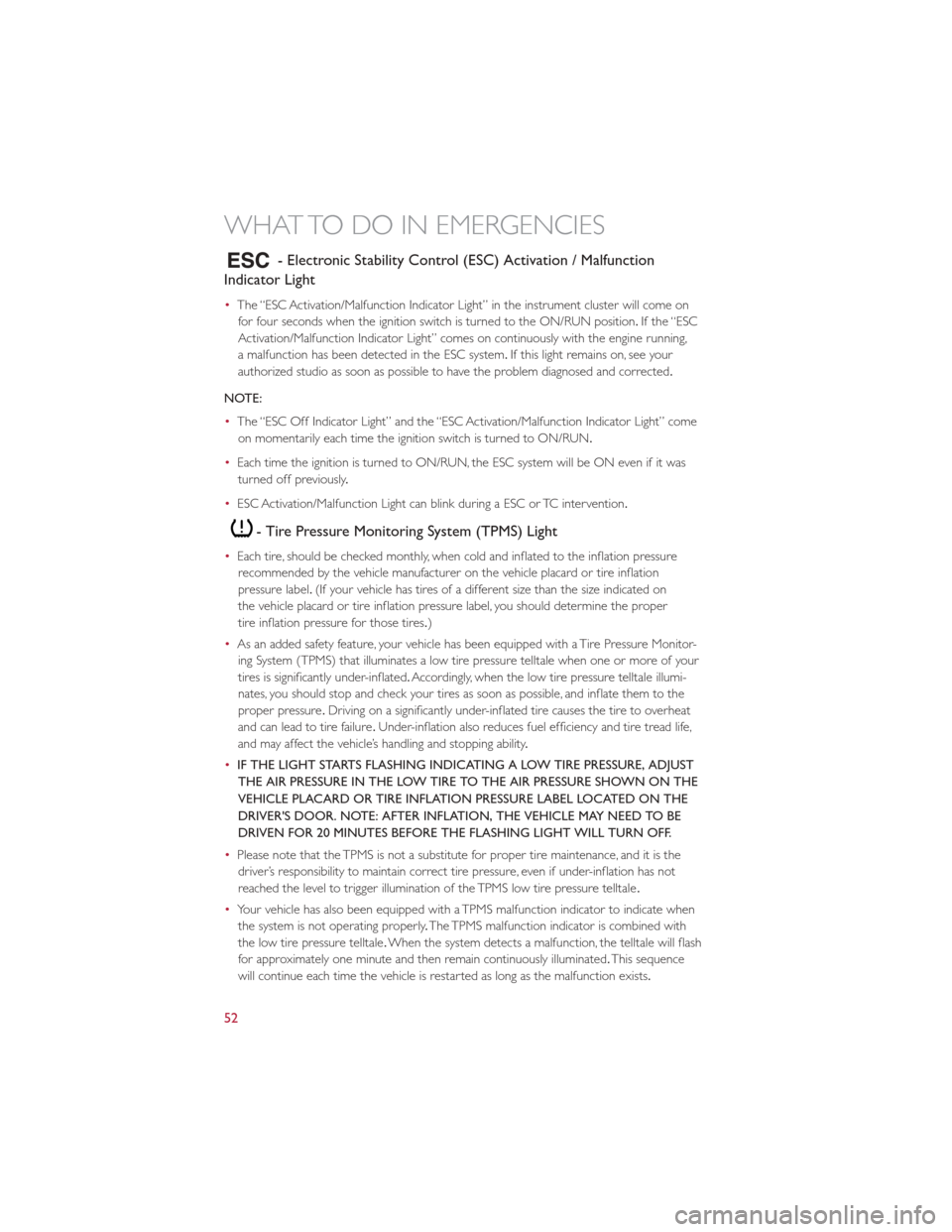stop start FIAT 500E 2013 2.G User Guide
[x] Cancel search | Manufacturer: FIAT, Model Year: 2013, Model line: 500E, Model: FIAT 500E 2013 2.GPages: 84, PDF Size: 1.56 MB
Page 19 of 84

NOTE:•The vehicle will initiate the charging cycle automatically when all the
conditions are satisfied.
• The vehicle battery gauge will show the pattern for charging.
• When charging is complete, or the
vehicle needs to be unplugged, remove
the EVSE by pushing the button on the
connector and pull firmly to remove it
from the vehicle’s charge receptacle .
8. Close the charge receptacle door .
NOTE:
• In the event of an error in the charging
process the AC power to the vehicle will
stop and a red indicator will illuminate on
the EVSE.
• Keep the door for the charge receptacle
closed when not in use .
Instrument Panel State Of Charge Indicator
• In addition to the instrument cluster the vehicle is also equipped with a State Of Charge
indicator .The indicator is made up of five lights that are mounted to the center of the
instrument panel.
• The State Of Charge indicator represents
the current state of charge for the high
voltage battery .The indicator lights quickly
identify the battery state of charge while
the vehicle is being charged. Each light
represents an incremental 20% level of
charge .Solid and blinking lights indicate
charge status similar to a mobile device .
NOTE:
In the event of an error in the charging
process the outer two lights will blink .
Number Of Indicator Lights Illuminated Percent Of Battery Charge
1 Light 0 – 20%
2 Lights 21 – 40%
3 Lights 41 – 60%
4 Lights 61 – 80%
5 Lights 81 – 100%
GETTING STARTED
17
Page 22 of 84

POWER DOOR LOCKS
•The vehicles power door locks are activated by moving the inside door handles.
NOTE:
The vehicle’s door must be closed to initiate this feature .
• Push or pull the door handle to lock or unlock the doors and liftgate when the doors are
closed.
SEAT BELT
• Be sure everyone in your vehicle is in a seat and using a seat belt properly .
• Position the lap belt across your thighs, below your abdomen. To remove slack in the lap
portion, pull up a bit on the shoulder belt. To loosen the lap belt if it is too tight, tilt the
latch plate and pull on the lap belt. A snug belt reduces the risk of sliding under the belt
in a collision.
• Position the shoulder belt on your chest so that it is comfortable and not resting on your
neck .The retractor will withdraw any slack in the belt.
• A shoulder belt placed behind you will not protect you from injury during a collision.
You are more likely to hit your head in a collision if you do not wear your shoulder belt.
The lap and shoulder belt are meant to be used together .
• A belt that is too loose will not protect you properly .In a sudden stop you could move
too far forward, increasing the possibility of injury .Wear your seat belt snugly .
• A frayed or torn belt could rip apart in a collision and leave you with no protection.
Inspect the belt system periodically, checking for cuts, frays, or loose parts .Damaged parts
must be replaced immediately .Do not disassemble or modify the system. Seat belt as-
semblies must be replaced after a collision if they have been damaged (bent retractor,
torn webbing, etc .).
• The seat belts for both front seating positions are equipped with pretensioning devices
that are designed to remove slack from the seat belt in the event of a collision.
• A deployed pretensioner or a deployed air bag must be replaced immediately .
WARNING!
In a collision, you and your passengers can suffer much greater injuries if you are not buck-
led up properly.You can strike the interior of your vehicle or other passengers, or you can
be thrown out of the vehicle .Always be sure you and others in your vehicle are buckled
up properly .
GETTING STARTED
20
Page 54 of 84

- Electronic Stability Control (ESC) Activation / Malfunction
Indicator Light
• The “ESC Activation/Malfunction Indicator Light” in the instrument cluster will come on
for four seconds when the ignition switch is turned to the ON/RUN position. If the “ESC
Activation/Malfunction Indicator Light” comes on continuously with the engine running,
a malfunction has been detected in the ESC system. If this light remains on, see your
authorized studio as soon as possible to have the problem diagnosed and corrected.
NOTE:
• The “ESC Off Indicator Light” and the “ESC Activation/Malfunction Indicator Light” come
on momentarily each time the ignition switch is turned to ON/RUN.
• Each time the ignition is turned to ON/RUN, the ESC system will be ON even if it was
turned off previously .
• ESC Activation/Malfunction Light can blink during a ESC or TC intervention.
- Tire Pressure Monitoring System (TPMS) Light
•Each tire, should be checked monthly, when cold and inflated to the inflation pressure
recommended by the vehicle manufacturer on the vehicle placard or tire inflation
pressure label. (If your vehicle has tires of a different size than the size indicated on
the vehicle placard or tire inflation pressure label, you should determine the proper
tire inflation pressure for those tires.)
• As an added safety feature, your vehicle has been equipped with a Tire Pressure Monitor-
ing System (TPMS) that illuminates a low tire pressure telltale when one or more of your
tires is significantly under-inflated. Accordingly, when the low tire pressure telltale illumi-
nates, you should stop and check your tires as soon as possible, and inflate them to the
proper pressure .Driving on a significantly under-inflated tire causes the tire to overheat
and can lead to tire failure .Under-inflation also reduces fuel efficiency and tire tread life,
and may affect the vehicle’s handling and stopping ability .
• IF THE LIGHT STARTS FLASHING INDICATING A LOW TIRE PRESSURE, ADJUST
THE AIR PRESSURE IN THE LOW TIRE TO THE AIR PRESSURE SHOWN ON THE
VEHICLE PLACARD OR TIRE INFLATION PRESSURE LABEL LOCATED ON THE
DRIVER'S DOOR. NOTE: AFTER INFLATION, THE VEHICLE MAY NEED TO BE
DRIVEN FOR 20 MINUTES BEFORE THE FLASHING LIGHT WILL TURN OFF.
• Please note that the TPMS is not a substitute for proper tire maintenance, and it is the
driver’s responsibility to maintain correct tire pressure, even if under-inflation has not
reached the level to trigger illumination of the TPMS low tire pressure telltale .
• Your vehicle has also been equipped with a TPMS malfunction indicator to indicate when
the system is not operating properly .The TPMS malfunction indicator is combined with
the low tire pressure telltale .When the system detects a malfunction, the telltale will flash
for approximately one minute and then remain continuously illuminated. This sequence
will continue each time the vehicle is restarted as long as the malfunction exists .
WHAT TO DO IN EMERGENCIES
52
Page 58 of 84

Sealing A Tire With TIREFIT
(A) Whenever You Stop To Use TIREFIT:
1.Pull over to a safe location and turn on the vehicle’s Hazard Warning flashers.
2. Verify that the valve stem (on the wheel with the deflated tire) is in a position that is
near to the ground. This will allow the TIREFIT Hoses (6) and (7) to reach the valve stem
and keep the TIREFIT kit flat on the ground. This will provide the best positioning of the
kit when injecting the sealant into the deflated tire and running the air pump .Move the
vehicle as necessary to place the valve stem in this position before proceeding.
3. Place the transmission in PARK (auto transmission) or in Gear (manual transmission) and
cycle the ignition to the OFF position.
4. Set the parking brake .
(B) Setting Up To Use TIREFIT:
1.Turn the Mode Select Knob (5) to the Sealant Mode position.
2.
Uncoil the Sealant Hose (6) and then remove the cap from the fitting at the end of the hose .
3.Place the TIREFIT kit flat on the ground next to the deflated tire .
4. Remove the cap from the valve stem and then screw the fitting at the end of the Sealant
Hose (6) onto the valve stem.
5. Uncoil the Power Plug (8) and insert the plug into the vehicle’s 12 Volt power outlet.
6. Do not remove foreign objects (e .g., screws or nails) from the tire.
(C) Injecting TIREFIT Sealant Into The Deflated Tire:
•Always start the engine before turning ON the TIREFIT kit.
• After pressing the Power Button (4), the sealant (white fluid) will flow from the Sealant
Bottle (1) through the Sealant Hose (6) and into the tire .
NOTE:
Sealant may leak out through the puncture in the tire .
• If the sealant (white fluid) does not flow within0–10seconds through the Sealant
Hose (6):
1. Press the Power Button (4) to turn Off the TIREFIT kit. Disconnect the Sealant Hose (6)
from the valve stem. Make sure the valve stem is free of debris. Reconnect the Sealant
Hose (6) to the valve stem. Check that the Mode Select Knob (5) is in the Sealant Mode
position and not Air Mode .Press the Power Button (4) to turn On the TIREFIT kit.
2.
Connect the Power Plug (8) to a different 12 Volt power outlet in your vehicle or another
vehicle, if available .Make sure the engine is running before turning ON the TIREFIT kit .
3.The Sealant Bottle (1) may be empty due to previous use .Call for assistance .
WHAT TO DO IN EMERGENCIES
56
Page 59 of 84

NOTE:
If the Mode Select Knob (5) is on Air Mode and the pump is operating, air will dispense
from the Air Pump Hose (7) only, not the Sealant Hose (6).
•If the sealant (white fluid) does flow through the Sealant Hose (6):
1. Continue to operate the pump until sealant is no longer flowing through hose (typically
takes 30 - 70 seconds). As the sealant flows through the Sealant Hose (6), the Pressure
Gauge (3) can read as high as 70 psi (5 kPa). The Pressure Gauge (3) will decrease
quickly from approximately 70 psi (5 kPa) to the actual tire pressure when the Sealant
Bottle (1) is empty .
2. The pump will start to inject air into the tire immediately after the Sealant Bottle (1) is
empty .Continue to operate the pump and inflate the tire to the pressure indicated on
the tire pressure label on the driver-side latch pillar (recommended pressure). Check the
tire pressure by looking at the Pressure Gauge (3).
• If the tire does not inflate to at least 26 psi (1.8 kPa) pressure within 15 minutes:
• The tire is too badly damaged. Do not attempt to drive the vehicle further .Call for
assistance .
NOTE:
If the tire becomes over-inflated, press the Deflation Button to reduce the tire pressure to
the recommended inflation pressure before continuing.
• If the tire does not inflate to at least 26 psi (1.8 kPa) pressure within 15 minutes:
1. Press the Power Button (4) to turn off the TIREFIT kit.
2. Remove the Speed Limit sticker from the top of the Sealant Bottle (1) and place the
sticker on the instrument panel.
3. Immediately disconnect the Sealant Hose (6) from the valve stem, reinstall the cap
on the fitting at the end of the hose, and place the TIREFIT kit in the vehicle storage
location. Quickly proceed to (D) “Drive Vehicle” .
(D) Drive Vehicle:
•Immediately after injecting sealant and inflating the tire, drive the vehicle 5 miles (8 km)
or 10 minutes to ensure distribution of the TIREFIT Sealant within the tire .Do not
exceed 55 mph (88 km/h).
(E) After Driving:
•Pull over to a safe location. Refer to “Whenever You Stop to Use TIREFIT” before continuing .
1.Turn the Mode Select Knob (5) to the Air Mode position.
2. Uncoil the Air Pump Hose (7) (black in color) and screw the fitting at the end of hose
(7) onto the valve stem.
3. Uncoil the power plug and insert the plug into the vehicles 12 Volt power outlet.
4. Check the pressure in the tire by reading the Pressure Gauge (3).
• If tire pressure is less than 19 psi (1.3 kPa), the tire is too badly damaged. Do not
attempt to drive the vehicle further. Call for assistance.
WHAT TO DO IN EMERGENCIES
57